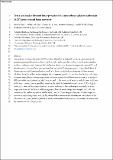Trace and major element incorporation into amorphous calcium carbonate (ACC) precipitated from seawater
Abstract
Amorphous calcium carbonate (ACC) has been identified or inferred to exist in many groups of marine organisms that produce biominerals widely used as geochemical archives (e.g. foraminifera, molluscs, echinoderms). However, little is known about trace element incorporation into ACC, and thus it is not understood how precipitation through an ACC precursor might impact the fidelity of climate proxies and biomineralisation models built on the skeletal geochemistry of these marine calcifiers. To address this, we investigated the incorporation of Li, B, Na, Mg, Mn, Sr, Ba, and U into inorganic amorphous calcium magnesium carbonates precipitated from seawater under a variety of different carbonate chemistries, Mg/Ca ratios, and in the presence of aspartic and glutamic acid, two of the most common intracrystalline amino acids found in foraminifera and corals. ACC is highly enriched in most of these trace elements relative to the crystalline carbonates yet similar in some respects in terms of the factors influencing trace element partitioning. For example, ACC B/Ca is sensitive to the carbonate system, whilst Mg/Ca and Sr/Ca are largely a function of their respective ratio in seawater. In general, we find that most of the variance in the distribution coefficients of the other trace elements can be explained by some combination of the seawater carbonate chemistry and the seawater or ACC Mg/Ca ratio.
Citation
Evans , D , Gray , W R , Rae , J W B , Greenop , R , Webb , P B , Penkman , K , Kroger , R & Allison , N 2020 , ' Trace and major element incorporation into amorphous calcium carbonate (ACC) precipitated from seawater ' , Geochimica et Cosmochimica Acta , vol. In press . https://doi.org/10.1016/j.gca.2020.08.034
Publication
Geochimica et Cosmochimica Acta
Status
Peer reviewed
ISSN
0016-7037Type
Journal article
Collections
Items in the St Andrews Research Repository are protected by copyright, with all rights reserved, unless otherwise indicated.

